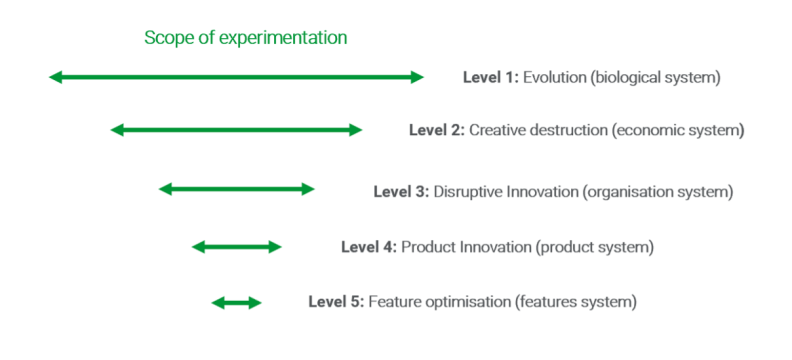Article
by Jon Stephens, Chief Product Officer
What Darwin, Schumpeter and Christensen can teach us about developing better products and services
The writings of Charles Darwin, Joseph Schumpeter and Clayton Christensen span almost 200 years and they are rarely compared, however, there is a common theme that runs through all of their work that holds the key to developing better products and services.
These thinkers all produced famous analyses of different systems. Darwin of course focused on biological systems, Schumpeter focused on economic systems and Christensen focused on market / organizational systems. There is a common theme across all of their analyses – that there is an underlying process of experimentation which selects the winners from the losers.
I like winning and rather dislike loosing. When I develop products and services for clients, I want them to win, to be successful. And I believe that the process these great thinkers all analyzed, experimentation, can also be used to select winning strategies, products, services, features and even user experience details.
Different levels of experimentation
The systems that Darwin, Schumpeter and Christensen analyzed can be thought of as being on different ‘system levels’, see Figure 1 below. Darwin’s biological system is at the top level because the experimentation has the broadest scope – every living thing. Schumpeter’s economic system is the next level down and Christensen’s market and organizational system level is next.
I believe there are at least two additional levels of experimentation within the organization, product level innovation and feature level optimization.
When we design innovation, product and feature experiments we need to use different types of experiment and different tools depending on what system level we are focusing on. An experiment to determine the best call to action on a product page should look different to an experiment to determine whether customers would buy a new product.
However, no matter what system level we are focusing on, we can develop better experiments by understanding what makes the forces of experimentation work on these other levels. The lessons learned in one level can often be applied at the other levels.

Figure 1: Applying experimentation to different system levels
Level 1: Evolution (biological system)
Darwin’s theory of natural selection (originally published jointly with Alfred Russel Wallace) is driven by key principles of variation and selection:
“But if variations useful to any organic being do occur, assuredly individuals thus characterized will have the best chance of being preserved in the struggle for life; and from the strong principle of inheritance, they will tend to produce offspring similarly characterized. This principle of preservation, I have called, for the sake of brevity, Natural Selection.” – Charles Darwin, On the Origin of Species, 1859
In biology, variation is driven by random mutations and selection pressure is driven by competition for food, shelter, and suitable reproductive partners. As I develop innovation strategies, products, and services, I try to think about the different ways that I can replicate these two conditions.
In the absence of mutations in the world of business, variations have to be engineered. Too much randomness could cause wasted effort, but equally opportunities will be missed if these variations are too narrow and only based on linear thinking. Bringing creativity into the process of developing variations (or, you could say, concepts or prototypes) is crucial – ideation methods such as SCAMPER and worst possible idea are some of my favorites that help with this.
Selection pressure usually comes from finite budgets in organizations, but we need to clearly define the level of evidence we need to decide which innovations, strategies, products or features we deem to be successful. In healthcare for example there is a tendency to assume that controlled, randomized academic studies are needed before the adoption of even quite small healthcare pathway changes. In reality this slows down innovation and performance improvement. Changes that don’t require clinical guideline changes could be adopted and evaluated much more quickly if less academic rigour is required. Having a clear framework for evaluation at the start can save a lot of subjective arguments, and time, later.
Level 2: Creative destruction (economic system)
The economic system of capitalism is really a giant machine for running experiments. Joseph Schumpeter developed the theory of creative destruction, which says that successful businesses and industries are developed by a continual cycle of creation of new, more efficient things, which destroy and replace the old, less efficient things. The success of an economic system depends on the intensity of the creative destruction process. The theory has three main principles:
- Success and growth is cumulative over time because the innovators of today stand on the shoulders of all those who came before them
- Creators of innovation are motivated by the possibility of a lucrative monopoly. Protecting the ability to do this e.g., through maintaining intellectual property rights, is critical in encouraging innovation
- Incumbents will fight and try to suppress innovation and so it is equally important to protect innovators from incumbents
When developing experiments in individual organizations (level 3 system) we can use these three principles as a useful reminder to:
- Think about how knowledge from successful and failed experiments is easily stored, codified, and accessed by everyone in a product team and an organization. In a previous company, we had a ‘failed innovation library’ and recorded ‘learning outcomes’ from each experiment on Confluence.
- Align incentives to successful innovation and product outcomes. This might be through bonus schemes or equity in new ventures, essentially replicating the role of market returns, but inside an organization.
- Plan to minimize ‘organ rejection’ when new innovations in a business threaten existing norms. Be like apple and don’t be afraid to develop the iPhone when you know it will kill the iPod. Identify the likely political, emotional and rational challenges from stakeholders in advance and address them as early as possible.
Level 3: Disruptive innovation (Organizational system)
The need for organizations to innovate in the face of disruption is most famously described by Harvard professor Clayton Christensen, originally in 1995 and updated more recently:
“Disruption” describes a process whereby a smaller company with fewer resources is able to successfully challenge established incumbent businesses. Specifically, as incumbents focus on improving their products and services for their most demanding (and usually most profitable) customers, they exceed the needs of some segments and ignore the needs of others. Entrants that prove disruptive begin by successfully targeting those overlooked segments, gaining a foothold by delivering more-suitable functionality—frequently at a lower price.”- Clayton Christensen.
When we are designing experiments, we should involve not just the most profitable customer segments but also to those which are less profitable and currently underserved. For incumbent organizations this can be a defensive strategy against disruption. For new entrants this can be a route to getting a foothold in a market, from where feature experimentation can then be targeted at moving upstream to serve more profitable customers.
Christensen also stresses that the disruptive process takes time and that not all disruptions are successful. When designing experiments we need to focus not just on the experiments themselves but on the processes we use to connect together and repeat experiments. For a previous client of mine I developed a system for experimentation that tested very specific hypotheses in small ‘sprints’ and then combined the more successful changes together into ‘pilots’, the impact of which were then evaluated over a longer time period.
We also need to ensure that we have appetite for failed experiments – at Microsoft for example only a third of experiments are successful, roughly a third fail and the other third are inconclusive. If you don’t manage expectations about failure rates you can find an experimentation program closed down before it has had a chance to demonstrate value.
Levels 4 and 5: Product and feature innovation (product and feature systems)
At these levels experiments can look very different depending on whether you are operating at level 4 or 5. At level 4, a product level, we should be experimenting with completely different products, features and business models. These experiments could be using paper prototypes, fake landing pages and commercial models to reduce costs and get to ‘product-market fit’ as quickly and cheaply as possible.
At a feature level it’s more about experimenting with specific changes in UI or UX, using A/B or multivariate testing to generate evidence that a variation should be selected over the existing experience. There’s now a myriad of platforms designed to help us run experiments like this at scale. Experimentation at this level is more about improving what exists already rather than inventing completely new things. That’s not to say this is not valuable, small changes can have huge impacts, as Airbnb found when changing the icon for shortlisting a property from a star to a heart increased engagement by 30%.
Summary
Experimentation at both the product and feature level can be improved by understanding the work Darwin, Schumpeter and Christensen, even though their work is focused on systems of experimentation that operate at different levels. Their work can prompt us to think about important experimentation questions such as:
- How do we engineer variation and create the right selection criteria?
- How do we capture, codify and use information from previous experiments to ‘stand on the shoulder of giants’?
- How can incentives be used to reward successful experimentation?
- How do we mitigate ‘organ rejection’ of successful innovations and experiments within an organization?
- How can the underserved and less profitable customer groups be a route to successful experimentation, for both incumbents and startups?
- How do we create the right processes for experimentation and manage expectations about the ratio of successes to failures?
Looking at systems beyond the one we are currently experimenting in can help us design better product and service experiments, although to fully answer the questions above we need to pair this with expert knowledge of the product or service system in which we operate.
Get in touch
Let us offer you a new perspective.


